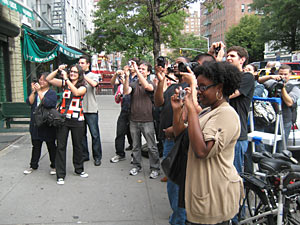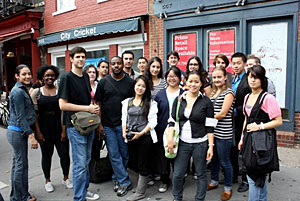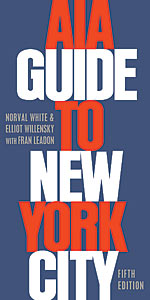|
Today in Manhattan’s Greenwich Village, 20 people aimed cameras at a three-story row house, snapped photos, and cheered. Part of the reason for their excitement may have been that the building was once the home of Jane Jacobs, the writer and activist. More likely, though, is that the picture-taking session marked the official end of the lengthy research phase for the fifth edition of the AIA Guide to New York City, the wryly written block-by-block directory of landmarks that’s become an essential reference for architects, planners, and developers, as well as residents.
About half of the new book, which is due in April from Oxford University Press, features content from earlier editions, most of which were written by architects Norval White and the late Elliot Willensky. A third contributor, Fran Leadon, AIA, a teacher at the City University of New York, joined the effort this go-around, roaming the five boroughs’ sidewalks over an 18-month period to research and photograph a good percentage of the book’s 9,000 buildings. Many of his former students also contributed to the new guide.
“It’s fantastic that it’s come to a close,” Leadon said during today’s event, attended by various contributors. “I’m so happy.”
The guide was first printed in 1968, with updated versions released in 1978, 1988, and 2000. A key reason for refreshing the book now is that since its last printing in 2000, an epic construction boom has transformed New York, adding scores of office towers, condos, and parks, Leadon said.


These get their due in the latest edition, as do burgeoning neighborhoods like Gansevoort Market, also known as the meatpacking district. Plus, the book will now feature “necrology” items about gone-but-not-forgotten buildings, similar to those that appeared in the third edition. Morever, the book’s 6,000 photos, which are being whittled down from a stack of 41,000, are larger on average than previously.
But, at 1,100 pages, the book is expected to be only slightly longer than the 1,056-page version released in 2000, which may explain the layout’s more compact font and smaller margins.
Although the new “AIA Guide” will predictably rhapsodize about, say, Grand Central Terminal, it also honors less-monumental places, like Jane Jacobs’ old home, which debuts in this edition, because overall the book is a celebration of neighborhoods, Leadon says. Similarly mentioned is Downtown Auto and Tire, a repair shop ringed by barbed wire at Great Jones Street and the Bowery, which is noted for its dying-breed status.
“The world is changing,” said owner Saeed Choudry today, gesturing to a gleaming hotel across the street. “There are no empty old lots left.”




Post a comment to this article
Report Abusive Comment